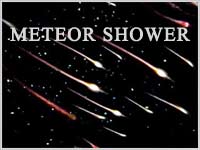A meteor shower is a sudden spurt in the number of meteors or shooting stars that streak through the night sky. Most meteor showers are spawned by comets. As a comet orbits the Sun it sheds an icy, dusty debris stream along its orbit. If the earth travels through this stream, we see a meteor shower. Although the meteors can appear anywhere in the sky, if you trace their paths, the meteors in each shower appear to come into the sky from the same region.

Most meteors are smaller than a grain of sand, so almost all of them disintegrate and never hit the Earths surface. Intense or unusual meteor showers are known as meteor outbursts and meteor storms, which may produce greater than 1,000 meteors an hour. This would help you to pitch your tents beforehand and be prepared for a visual treat from the night skies.
Quadrantids 2016 The Quadrantids are an easily visible January meteor shower. The entire activity period of the Quadrantids runs from January 1 to 5, 2016.
The radiant of this shower is an area inside the constellation Botes. The name comes from Quadrans Muralis, an obsolete constellation that is now part of Botes. It lies between the end of the handle of the Big Dipper and the quadrilateral of stars marking the head of the constellation Draco.
Peak of Quadrantid meteor shower 2016 The maximum of the Quadrantid activity in 2016 is expected during the night of the 3rd January 2016. The Quadrantids are an easily visible January meteor shower.
Peak of Perseid meteor shower 2016 The maximum of the Perseid activity in 2016 is expected during the night of the 12th August 2016. The Perseids is the name of a prolific meteor shower. The shower is visible from mid-July each year, with the peak in activity being between August 9 and 14, depending on the particular location of the stream.
Leonids 2016 The Leonids are a meteor shower associated with the comet Tempel-Tuttle, which is visible between the 14th and 21st of November 2016. The Leonids get their name from the location of their radiant in the constellation Leo: the meteors appear to radiate from that point in the sky. The Leonids tend to peak in November.
Peak of Leonid meteor shower 2016 The maximum of the Leonid activity in 2016 is expected during the night of the 17th November 2016. The Leonids are a prolific meteor shower. It tends to peak around November 17, but some are spread through several days on either side and the specific peak changing every year.